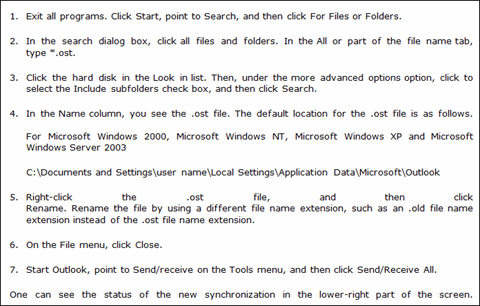"Outlook is Not Syncing with Exchange" Error - Fixed Up
The write-up describes the method to troubleshoot syncing problem with Exchange Server Mailbox via OST file in Outlook.
Find out whether Offline file and folder synchronized or not
Once determined that .ost folders are synchronized properly, follow the steps mentioned below:
1 - First of all, right click on the folder to be verified, click properties
2 - Then check for the synchronization tab.
3 - If unable to find, it means profile is not set for offline users.
4 - Verify the settings under statistics for the folder
| Last sync on >> Date |
| Server Folder contain >> #Items |
| Offline Folders contain >> #Items |
If sync is working properly, then the number of items in Server folder and offline folder comprises of fields. If the sync does not work properly, one should verify the folder settings. For this purpose, follow the below mentioned steps:
For MS Outlook 2003
1. Click email Accounts in the Tools menu
2. Email Accounts dialog box >> view/change existing account >> next
3. For delivering new mail, assure that mailbox-account name is selected
4. Click MS Exchange Server object >> Click change
5. Make sure use cached Exchange Mode option is selected, click next
6. Click on Finish >> OK then Exit Outlook and Reopen it
For MS Outlook 2007
1. Click Account Settings on the Tools menu
2. Click Data Files and make sure Mailbox-account name is set as default
3. Open email tab and click on Mailbox-account name, then settings
4. Hit on Advanced tab, verify Use Cached Exchange Mode is selected>> Click ok
5. Click Account Settings dialog box >> close >> exit Outlook >> reopen Outlook
For MS Outlook 2010
1. File menu>> Account Setting >> Select Account Settings
2. Click Data files tab and assure Mailbox-account name is set as default
3. Click email tab>> check mailbox account name >> change
4. Verify Use Cache Exchange Mode is selected >> click ok
5. Close accounts setting dialog box>> exit Outlook>> Open Outlook
Different Ways to Synchronize Offline Folders
Once the settings are checked, use the method mentioned below to sync folders.
Way 1: Manual Approach
a. Click the folder to be synced
b. Synchronize the Offline folder
c. One can synchronize the offline folder by send/receive option in the tool menu. Even, one can opt for send/receive all to synchronize all the offline folders. Once syncing of folders is started, one will receive a message that the entire process will take more than 30 minutes.
Way 2: Automatic Approach
a. To sync offline folder automatically follow the steps mentioned below:
b. Tools menu>> Click OK
c. Click on Mail Setup
d. In Send/Receive section>> Send immediately when connected
e. Click Send/Receive tab
f. Send/Receive Groups dialog box>> Perform Automatic send Receive
g. Click Close and then hit on Ok button
Create new OST file and sync Offline Folders
If one has synced all the folders excluding inbox, or one is unable to sync all the folders, then it is a damaged .ost file. To resolve the issue that Outlook is not syncing with Exchange, create a new .ost file.
How to create and synchronize OST file folders?
First of all, make a new OST file and rename the old one. Sync the new .ost file from system. Follow the steps present in the screen shot:

Recommended Solution : A core technical person can perform the process easily. But, for a non-tech user it becomes difficult to perform the same. While performing, a non-technical person finds it difficult to perform it. Even, in technically savvy person's case, a single mistake can lead to data loss or issues like corruption. So, to reduce such corruption issues, one should try OST File to PST Converter Free Tool. It's a OST Repair tool which solves the issues in a single shot.
The above mentioned blog solves every query of a user regarding Outlook is not syncing with Exchange. In the blog, the users will even find the manual approach and the automated approach to resolve the issue regarding Outlook is not syncing with Exchange.